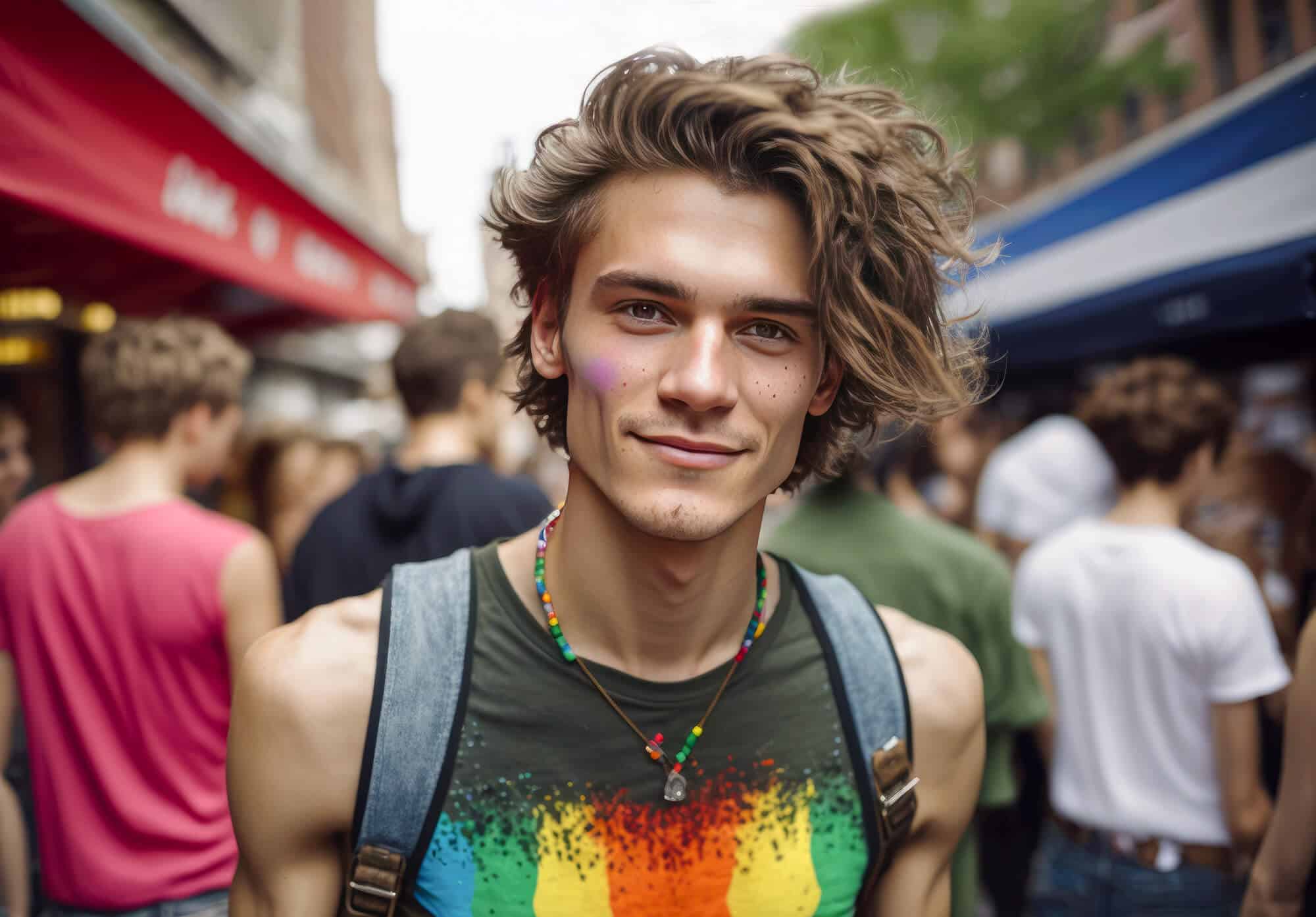
In the past few decades, we’ve made some incredible advances in our exploration of gender identity and relationships. And overturned some pretty major laws and stigmas towards LGBTQ+ folk. But, there’s still a long way to go.
It’s no secret that the concept of bisexuality is still a difficult one for many to wrap their minds around.
Our society, with its underlying dualistic principles, often likes to keep things neat and orderly. Viewing everything in crisp binary terms. As a result, the notion of being attracted to individuals across multiple genders isn’t always something that is readily understood or accepted.
According to sex therapist Jasmine Lee, “Revealing one’s bisexuality can be a far more difficult experience than it is for individuals who classify themselves as either homosexual or heterosexual.”
“LGBT folks never had the privilege of assuming their loved ones and peers share their orientation – however, those with heterosexual identities are fortunate to benefit from this assumption,” she says.
Understanding human sexuality is not always an easy task due to our struggle of accepting it as a fluid and ever-changing concept.
“People are SO much more than fitting into tiny boxes or labels,” mentions Lee.
“Past, present and future events all shape how we identify with our sexual orientation. We use labels to enhance conversations but they don’t adequately represent the spectrum of emotions such an intimate topic can evoke.”
Throughout her career, Lee has seen many people defy the confines of strict categorization, changing their sexuality over time. “I’ve encountered individuals who initially thought they were heterosexual, yet ended up in same-sex partnerships; those who assumed they favored one gender, only to occasionally move toward the opposite; and some who regularly fluctuated on the spectrum.”
It’s important to take your time when it comes to understanding yourself and the attractions you feel. Don’t rush thinking that you have to have a definitive label for yourself. Give yourself time and space to explore different possibilities.
What Is Bisexuality and How Can I Identify It?
Being bisexual, or bi, means being attracted to all genders. That could include men, women, trans, non-binary, or gender non-conforming people.
“Bisexuality doesn’t necessarily mean being equally interested in both men and women; it could mean having more attraction for one gender over another,” says Lee.
Some might be in same-sex relationships, some in opposite-sex relationships. And some may choose not to have sexual contact at all.
“It’s important to remember that bisexuality is not a “grey zone”; it is a valid sexual orientation in its own right that is different from being gay or straight,” she says.
There are still many misconceptions and negative stereotypes surrounding bisexuality. So it’s important to educate yourself about the diversity of sexuality.
It’s also important not to make assumptions about someone’s sexuality or gender identity based on their appearance or lifestyle.
“It’s also important for people who don’t identify as bi to show respect towards those who do by recognizing that they can experience attraction within the spectrum between gay & straight orientations,” says Lee, “without trying to pigeonhole them into labels or boxes they may not fit into perfectly”.
Unraveling the Myths: Decoding Bisexuality’s Stereotypes
When it comes to exploring one’s sexuality, it can be confusing trying to understand the many facets and labels that come with it.
From homosexual to heterosexual, bisexuality is often wrongly viewed from a single perspective with considerable misunderstanding.
Although attitudes have shifted in recent years, many still feel compelled to question or even reject the idea of being bisexual. Often assuming false stereotypes such as promiscuity or a lack of commitment.
With these misconceptions still commonplace, it’s important for us all to take a step back and assess our understanding of this complex subject.
Lee states: “Clear communication and honest dialogue are key components in understanding human sexuality – but unfortunately society has not always been so accepting of orientations outside the heterosexual and homosexual norms”.
According to Lee, some of the most common stereotypes bisexual people must deal with are:
- They are not ‘bi-enough’, meaning they are either just trying to be trendy or they are ‘confused’;
- They don’t really exist, as seen in the phrase “there’s no such thing as bisexuality”; or
- They must be attracted to one gender more than the other in order to truly identify as bisexual.
“It’s important to recognize how damaging these stereotypes can be and to understand that each person’s sexuality is as unique as they are,” says Lee.
Bisexuality should never be questioned or discredited. Rather, it should be embraced, respected, and celebrated. It is a legitimate form of orientation that deserves recognition and acknowledgment.
Exploring Your Sexual Feelings: Knowing If You Might Be Bisexual
“Experiencing sexual desire is a very personal journey and when it comes to bisexuality, not everyone has the same story,” reiterates Lee.
Revealing one’s bisexuality can be challenging if there’s fear that people might not understand or accept it. But with greater public awareness about different sexual orientations, more and more people are feeling empowered to be open about their own feelings.
The truth is that understanding one’s sexuality can sometimes be difficult due to how complex and ever-changing it is. Moreover, labels don’t always accurately convey the emotions that sex can evoke in different individuals.
That’s why it’s important to pay close attention to your personal feelings and desires without being swayed by societal stereotypes or expectations. Here are a few things you should consider:
- Do you experience sexual arousal for both men/women? Are these feelings similar or different? It’s important to remember that just because you’ve watched a few gay or transsexual porn videos on Pornhub doesn’t make you bi or trans. Plenty of straight guys watch gay and transsexual porn purely for the arousal from the sex act itself, not because they are romantically attracted to the performers.
- Do you want romantic relationships with both sexes? How do they differ from each other in terms of emotions and attraction?
- Are there any social stigmas attached to your desires (e.g., family pressures, religious inhibitions) that make you feel uncomfortable expressing your sexuality?
- How do you imagine yourself in relationships with potential partners of the same sex or opposite sex?
If after exploring these questions, you still aren’t sure about whether you’re bisexual or not, Lee suggests talking to someone who could provide some guidance. Like a therapist or somebody from your local LGBT center. So they can help navigate this process with respect and understanding.
“It’s okay if labeling yourself feels daunting; support from those around you can help tremendously”.
Coming Out and Taking the Next Steps on Your Journey
Once you have revealed your bisexuality to those around you, the next step is understanding and accepting yourself. Taking the time to explore and embrace your identity can be a difficult process, but one that is essential in finding a sense of belonging.
Lee underscores the importance of this journey: “It is important to remember that coming to terms with one’s sexuality is a process. It requires patience, self-compassion and understanding that there will be bumps along the road.”
Building up your resilience through self-care practices such as mindfulness and creating supportive networks of people who accept you for who you are can help immensely in your road towards acceptance.
At the same time, it’s important not to put too much pressure on yourself. Everyone has their own timeline when it comes to understanding their identity.
Reaching out for necessary resources can also be beneficial. Whether it’s speaking with trained counselors or attending LGBT support groups in your area. As Lee says, “Taking small steps towards finding meaningful connections and relationships within the community can go a long way in embracing your true self.”
“Having a therapist or even close friends can be incredibly helpful in creating an environment where you feel secure enough to express your emotions,” says Lee. She underlined the importance of being mentally prepared for potential negative reactions from both gay and straight peers.
“Try discussing your feelings with somebody trustworthy first – ask them to be your support system!”
Ultimately, discovering and embracing our true sexual identities can be liberating but it will require hard work at times.
Lee stresses that “Taking care of ourselves by making sure we have adequate support systems in place combined with developing healthy coping mechanisms will set us up for success on this journey to self-discovery”.



